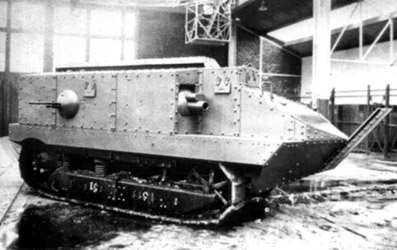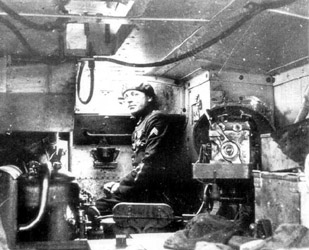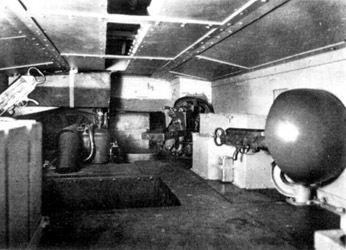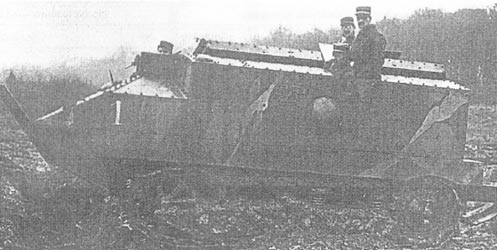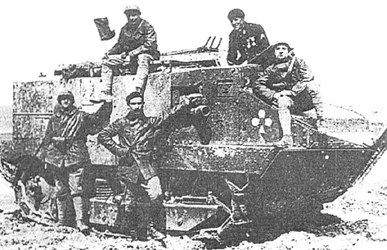| 1-Vehicles / Allies / France / 1-Tanks / Files / Schneider-CA1.htm | Last Up-date: 28-09-2018 | |||||||||||||||||||||||||||||||
Schneider C.A.1 Genesis La rencontre entre le colonel Estienne et l'ingénieur Brillé (Schneider-Creusot) donna naissance en décembre 1915 au projet d'un premier char français. En janvier 1916, Joffre donna son accord pour la continuation du programme et passa à la fin du mois une commande de 400 exemplaires de ce "cuirassé terrestre" doté d'un canon de 75 mm. The
meeting between colonel Estienne and the engineer Brillé (Schneider-Creusot)
gave birth in December 1915 to the project of a first French tank.
In January 1916, Joffre gave its agreement for the continuation of
the program and placed at the end of the month an order of 400 specimens
of this " land battleship" equipped with a gun of 75 mm.
Design L'équipage était composé du commandant (le plus souvent un officier), un sous-officier, un pilote, un canonnier et deux mitrailleurs. Le char Schneider C.A.1. avait l'apparence d'une grosse caisse allongée installée sur un châssis constitué de deux longerons réunis par des traverses. Le châssis était posé via des ressorts sur deux chariots (avec 3 et 4 galets). Le chariot avant était doté d'une poulie de tension. La chenille composée de 34 patins était soutenue par des rouleaux installés entre deux flasques. Le moteur installé à l'avant était un quatre cylindres réalisé spécifiquement par Schneider pour ce nouveau véhicule. Il développait 60 ch à 1200 t/m. Le réservoir était plus bas que le carburateur et l'alimentation se faisait grâce à une pompe. La transmission installée à l'arrière comprenait un embrayage à trois rapports multiples et deux embrayages secondaires qui agissaient chacun sur les barbotins (installés à l'arrière), ce qui permettait de ralentir ou arrêter une des chenilles pour changer de direction. The crew was composed of the commander (generally an officer), a warrant officer, a driver, a gunner and two machine gunners. The tank Schneider C.A.1 had the appearance of a big lengthened box installed on a chassis made up of two members joined together by cross-pieces. The chassis was posed via springs on two carriages (with 3 and 4 road-wheels). The front carriage was equipped with an idler. The track made up of 34 links was supported by rollers installed between two flasks. The engine installed in front was one four cylinders specifically realized by Schneider for this new vehicle. It developed 60 hp to 1200 rpm. The fuel tank was lower than the carburettor and feeding was done thanks to a pump. Transmission installed at the back included a clutch with three multiple speeds and two secondary clutches which operated each one the sprocket-wheels (installed at the back), which made it possible to slow down or stop one of the tracks to change direction.
Les mécanismes étaient installés sur des roulements à rouleaux ou à billes et étaient actionnés grâce à des leviers et des pédales dans la station de pilotage à l'avant, juste à droite du moteur. La redoute en acier trempé à l'avant était à l'épreuve des projectiles du fusil Mauser à une distance de 150 m. L'observation était possible via des fentes de tir horizontales et des hublots à volets réglables. L'accès était possible grâce à une porte située à l'arrière. Une ouverture couverte sur le toit permettait l'aération du char. L'éperon à l'avant empêchait le char d'enfoncer son étrave quand le char basculait en avant. Deux queues à l'arrière avaient le même fonction. L'armement principal du char Schneider était constitué d'un canon court de 75 mm qui mettait à feu des obus explosifs avec une vitesse initiale de 200 m/s. Le tir de cette arme était précis jusqu'à 200 m, bien que la portée utile atteignait 600 m. Ce canon possédait un pointage en site de -10° à +30° et un débattement de 60°. L'armement du char Schneider était complété par un mitrailleuse Hotchkiss modèle 1914 sur chaque flanc, installé sur rotule oscillante. Chaque mitrailleuse possédait un pointage en site de -45° à +20° et un débattement de 53° de chaque côté. The mechanisms were installed on ball or roller bearings and were actuated thanks to levers and pedals in the driver's station in front, just on the right of the engine. Glacis in tempered steel in front was projectiles of Mauser rifle proof at a distance from 150 m. The observation was possible via horizontal slits of shooting and port-holes with adjustable shutters. The access was possible thanks to a door located at the back. An opening covered on the roof allowed lthe ventilation of the tank. The spur in front of the tank prevented to insert its stem when the tank rocked ahead. Two tails at the back had the same function. The main armament of the Schneider tank was made up of a short gun of 75 mm which put at fire high-explosive rounds with an initial speed of 200 m/s. The shooting of this weapon was precise until 200 m, although the useful range reached 600 m. This gun had an elevation of -10° to +30° and a traverse of 60°. The armament of the Schneider tank was supplemented by a machine-gun Hotchkiss model 1914 on each side, installed on oscillating ballmount. Each machine-gun had an elevation of -45° to +20° and a traverse of 53° on each side.
Initial Shielding of the Schneider tank was vulnerable to the German projectiles of " type; K" and was quickly reinforced by additional armored plates of 5.5 mm placed at approximately 40 mm of the shielding of origin. This device however was limited to the exposed parts of the tank and increased its weight of 500 kg. Another disadvantages of the Schneider tank, its ventilation and the presence of the gasoline tank in the cockpit which made run to the tank important fire risks. One thus moved the fuel towards the back in two armored fuel tanks of 100 L each one. Ventilation was also improved. It was still projected to realize other improvement like a tank C.A.2 equipped with a swivelling turret armed with a gun of 47 mm and a tank C.A.3 with prolonged hull and double turret. None of these versions will be put in production.
Schneider in Action Le char Schneider C.A.1 connu son baptême du feu le 16 avril 1917 à Berry-au-Bac (Chemin des Dames) à raison de 128 exemplaires. L'organisation prévue consistait en groupes de quatre batteries dirigés par des capitaines ou des commandants. Chaque batterie était constituée de 4 chars. Les groupements de 4 groupes étaient dotés d'une section de réparation et de ravitaillement. Seize groupes furent constitués et leur dotations fut finalement réduite à 3 batteries de 5 chars par groupe. Le char Schneider fut créé à l'origine pour effectuer des actions de rupture mais sa vulnérabilité le cantonna vite à des actions de soutien d'infanterie en compagnie des chars Renault FT à partir de 1918. Après l'Armistice, les survivants furent retirés du service. The Schneider C.A.1 tank known its baptism of fire on April 16, 1917 at Berry-au-Bac (Chemin des Dames) at a rate of 128 specimens. Organization envisaged consisted of groups of four batteries directed by captains or commanders. Each battery consisted of 4 tanks. The groupings of 4 groups were equipped with a section of repair and supply. Sixteen groups were made up and their equipments was finally reduced to 3 batteries of 5 tanks by group. The Schneider tank was created at the origin to realize actions of breakthrough but its vulnerability quickly confined it to actions of support of infantry in company of the tanks Renault FT as from 1918. After Armistice, the survivors were withdrawn from the service.
|
|||||||||||||||||||||||||||||||
